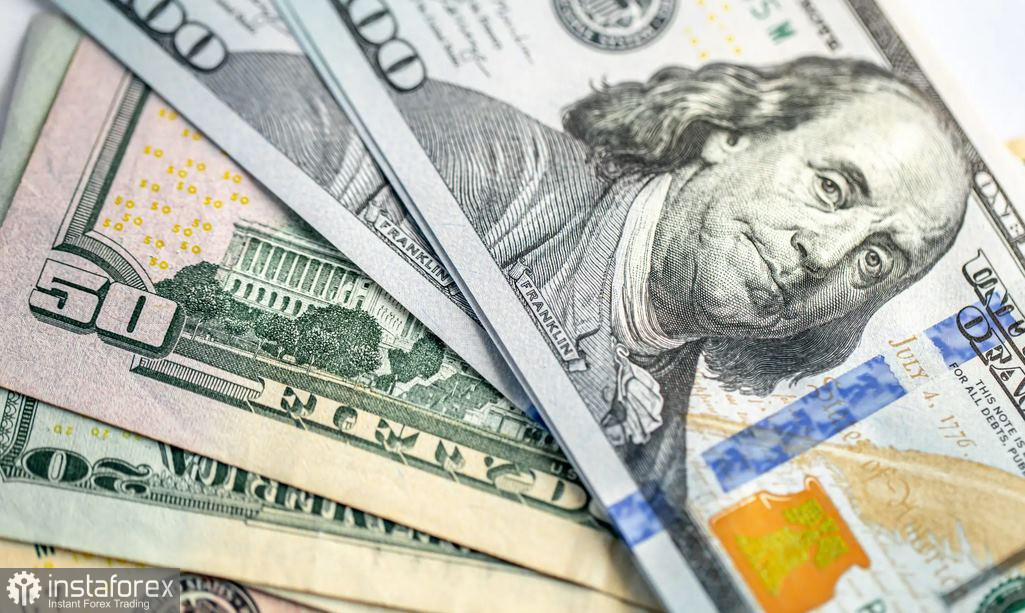April brought good news for the dollar. At least yesterday's release favored the dollar bulls, allowing the greenback to strengthen its positions across the market. This includes its pair with the euro: the EUR/USD price sharply declined and is currently testing the support level at 1.0730 (the lower line of the Bollinger Bands indicator on the daily chart). The downward trend is gradually gaining momentum, causing the sixth figure to loom on the horizon.

Such price dynamics are mainly due to the strengthening of the American currency: the U.S. dollar index approached the 105th figure, updating almost two-month highs. Additional support for the greenback is provided by the yield on 10-year Treasury yields, which remains above the 4.3% target. The euro, in turn, is under pressure from dovish comments from ECB officials. March data on inflation growth in the eurozone, which will be published on April 3rd, could exacerbate the situation for the single currency. According to preliminary forecasts, both the overall and core consumer price indices are expected to show a downward trend. If the report meets expectations (or falls into the red zone), the likelihood of the ECB lowering rates in June will significantly increase.
Essentially, in this case, the June prospects for monetary policy easing will depend on wage indicators. Note that wage agreements in the eurozone in the fourth quarter of last year increased by 4.5%. This is a high value, but lower than in the third quarter (4.7%). If this indicator also demonstrates a downward trend in the first quarter of 2024 (we will find out about this in May), the question of rate cuts at the June meeting will be resolved. In the current circumstances, labor costs are a key factor in making the appropriate decision.
But let's get back to the American events. Yesterday's surge in the dollar was driven by a strong report on the growth of the ISM Manufacturing Index. Firstly, the index ended up in the green zone. According to forecasts, this indicator was expected to rise to 48.5 points in March (after the February decline), but instead, it sharply jumped to 50.3 points.
Secondly, the manufacturing index was in the expansion zone for the first time since October 2022, i.e., above the key mark of 50.0. Production volume increased, and demand was in positive territory. The report structure indicates that the employment index rose to 47.4 (from the previous value of 45.9), the prices paid index, a component of inflation, rose to 55.8 (from 52.5), and the new orders index increased to 51.4 (from 49.2).
As mentioned earlier, in March, the ISM Manufacturing Index disappointed the dollar bulls—instead of the expected growth, it decreased to 47.8. This month, the situation was reversed: a strong index allowed the dollar index to update multi-week highs, and sellers of EUR/USD to decrease towards the base of the seventh figure.
It is noteworthy that traders of the pair essentially ignored the core PCE index, which was published last Friday. Recall that this key inflation indicator for the Fed decreased again (for the seventh consecutive month), reaching 2.8% YoY in February. The market's phlegmatic reaction is explained by the fact that this report came out as expected and essentially did not change market expectations.
According to the CME FedWatch Tool, the probability of a rate cut at the May meeting is now 1%, meaning the market is almost 100% confident that the Fed members will maintain the status quo at the next meeting. As for the June meeting, the probability of a rate cut is 60%. The core PCE index was unable to move this value either left or right.
Thus, the EUR/USD pair ignored the inflation report and reacted quite sharply to the ISM Manufacturing Index. At the same time, the pair failed to impulsively overcome the support level of 1.0730 (the lower line of the Bollinger Bands indicator on the D1 timeframe). Today, the price is moving more by inertia from yesterday's trading in anticipation of the main events on Tuesday.
In addition to the publication of inflation data in Germany, today (during the American session), several representatives of the Fed will give a speech: Board of Governor member Michelle Bowman, New York Fed President John Williams, Cleveland Fed President Loretta Mester, and San Francisco Fed President Mary Daly. Since all of them have voting rights in the Committee, their comments will provoke significant volatility in the EUR/USD pair. Whether in favor of the dollar or against the American currency, the question remains open.
From a technical standpoint, the pair on the daily chart is at the lower line of the Bollinger Bands indicator (1.0730), as well as below all lines of the Ichimoku indicator (including the Kumo cloud), which demonstrates a bearish "Parade of Lines" signal. If the pair breaks the support level of 1.0730, the next targets for the downward movement will be the level of 1.0650 (the middle line of the Bollinger Bands indicator on the MN timeframe) and the psychologically significant level of 1.0600.
 English
English 
 Русский
Русский Bahasa Indonesia
Bahasa Indonesia Bahasa Malay
Bahasa Malay ไทย
ไทย Español
Español Deutsch
Deutsch Български
Български Français
Français Tiếng Việt
Tiếng Việt 中文
中文 বাংলা
বাংলা हिन्दी
हिन्दी Čeština
Čeština Українська
Українська Română
Română

